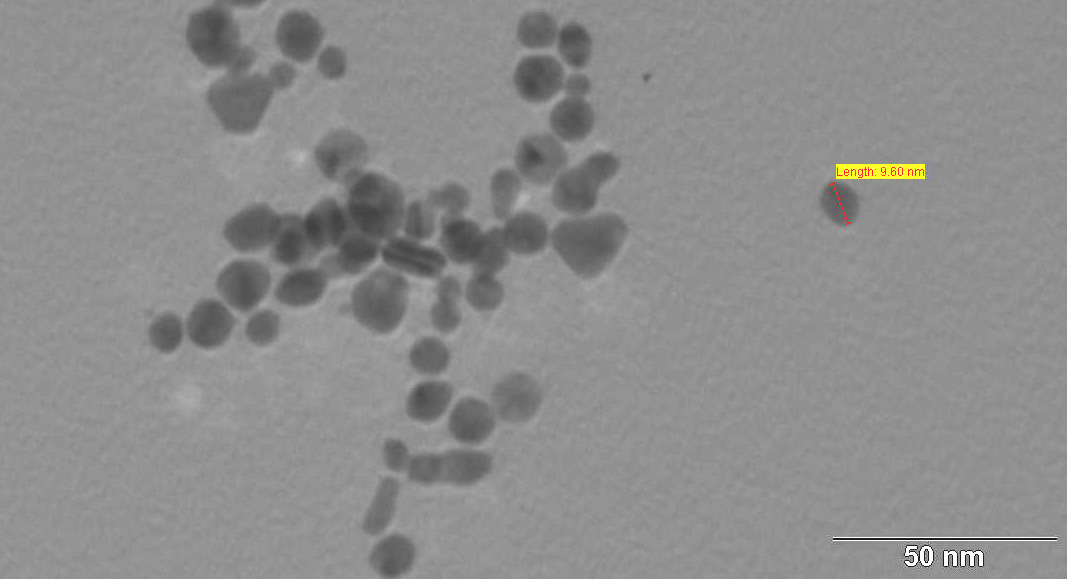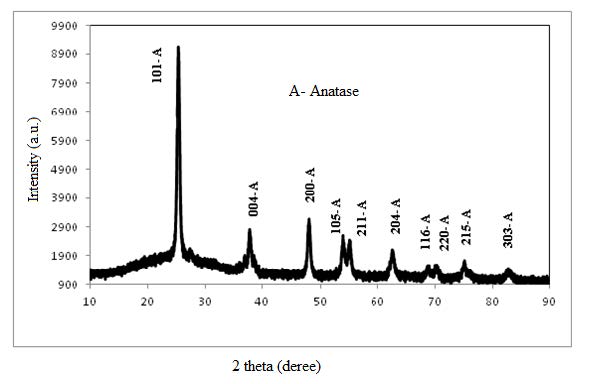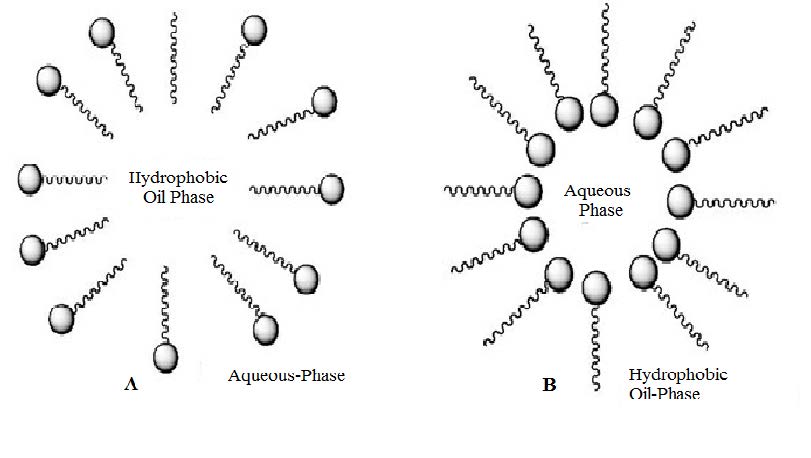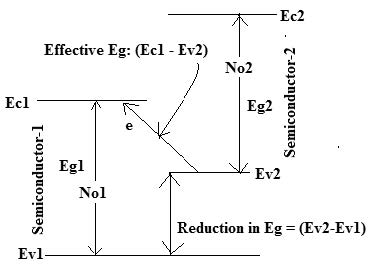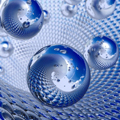1. Introduction
Titanium is the ninth most abundant element on the earth, which is present in igneous rocks and the sediments derived from them. Titanium dioxide (TiO2) is the natural form of Titanium and occurs in three crystal structures namely, rutile, anatase and brookite, which are tetragonal and rhombohedral. The interest in studying Titanium dioxide by the researchers has increased since the first report of photo-catalytic splitting of water on a TiO2 electrode under UV light, by Fujishima’s group [1]. TiO2 is also called as Titania. Moreover, Titanium dioxide being a semiconductor compound exhibits remarkable dielectric, electronic and physico-chemical surface properties [2].
With advent of time interest in nano form of Titanium has increased because, it is a well-known functional material, which has various applications such as pigments in paints, in cosmetics, as a photocatalyst, sensor material and as electrode of photovoltaic cell [2]. It is also widely used in industrial applications due to its non-toxicity, low cost, chemical stability [3,4]. It is used as a binder in many medicines. It has shown to be effective in the destruction of micro-organisms such as bacteria and viruses, the photosplitting of water to yield hydrogen gas, fixation of nitrogen, cleanup of oil spills and control of odors, which makes it a promising candidate to be applied as environmentally benign photocatalyst. It is also widely used as photocatalyst for conversion of solar energy, photochromics and photovoltaics because of its unique optical and electrical properties [5]. It has received great attentions because of its chemical stability and high reactivity under UV light irradiation [4,6,7,8,9] especially the photocatalytic activity.
2. Photocatalysis
Photocatalysis as the name suggests is a material (catalyst) that can speed up a reaction in presence of light. A photocatalyst should have light absorption properties, can generate electron-hole pairs and are capable of generating charge carriers when stimulated with required amount of energy (Figure 1). Photocatalytic reactions could be homogeneous or heterogeneous. One of the important feature of a photocatalyst is that it should have desired band gap, suitable morphology, high surface area, stability and reusability [10,11,12]. Many metal oxides (Titanium, Vanadium, Chromium, Zinc, Tin and Cerium) have these properties. During photocatalytic processes these oxides absorbs UV or visible light and gets activated, which induces a charge separation process with the formation of positive holes that oxidizes organic substrates. The photocatalytic activity of metal oxide comes from two sources: (i) generation of ·OH radicals by oxidation of OH− anions, (ii) generation of O2· radicals by reduction of O2. Both the radicals and anions can react with pollutants to degrade or otherwise transform them to lesser harmful byproducts.
Titanium oxides has been used as a photocatalyst to decompose toxic organic compounds, photovoltaics, prevent fogging of glass and even split water into hydrogen and oxygen [13,14,15,16].
Semiconductor (TiO2) + band gap light → electron/hole pair
Photo generated electron/hole diffuses to the surface. With n-type material hole will appear on the surface exposed to light and electron will appear at the back side of the material, which is not illuminated. Reverse would be the case with p-type semiconductor [1].
Electron(surface) + Org → Reduced (org) product
hole(surface) + Org → Oxidized (org) product
3. TiO2 as Photocatalyst
TiO2 is a most widely used catalyst for photocatalytic degradation of organic compounds in presence of sunlight. TiO2 has found application in solving many environmental problems because of its high catalytic efficiency, stability and reasonable cost. TiO2 exhibits band gap energy of 3 eV. TiO2 exists in 3 crystalline phases, i.e., anatase, rutile and brookite. Anatase phase has highest photocatalytic efficiency [17,18].
Majority of work on use of TiO2 is done by using TiO2 of 20-50 nm diameters (Figure 2). The nanosized TiO2 is better than large size TiO2, because nano-metal clusters and semiconductors of nanosize exhibit novel size dependent optical, chemical and electronic properties. Moreover, compounding TiO2 with other metal to enhance the photocatalytic activity has been tried, e.g., Amaratunga [19] has fabricated TiO2 and gold nanocomposite, because gold nanoparticles can enhance photocatalytic efficiency of TiO2 by charge separation. There are very many other advantages of forming nanocomposites, e.g., by changing the ratio of gold and TiO2 the photocatalytic activity can be tuned. Most of the work is carried by a plate of Ti whose surface is oxidized to form TiO2 [20], or powder of TiO2 spread over ITO or FTO glass or suspension of TiO2 nanosized powder [21]. Very little work has been carried out to explain which side of the faces of the crystal of TiO2 is more photoactive as compared to other facet of TiO2 crystal. Pradhan et al. [22] have shown that Au-TiO2 had enhanced photocatalytic activity as compared to the TiO2. The Au-TiO2 heterodimer showed well-defined Photoluminescent property, which were consistent with the electronic transition involving trap state of TiO2 nanoparticles. This facilitated charge separation of photogenerated electrons and holes at the Au-TiO2 interface. From their studies, they have concluded that (i) There were 2 positive pathways for photogenerated electrons at the TiO2 conduction band, decay to the trap state and transfer to the gold nanoparticles and (ii) energy/electron transfer from the trap state to gold nanoparticles was less efficient.
No wonder attention has been focused by many to develop a suitable method to produce nanoparticles of TiO2 as well as various TiO2 conjugates to get desired material for various applications, especially dye degradation.
In the following paragraphs different method of synthesis are touched upon in very brief.
4. Limitations of TiO2 as Photocatalyst
TiO2 because of its many desirable properties, such as high activity, chemical stability, robustness against photo-corrosion, low toxicity, no secondary pollution, low cost and water insolubility under most conditions; has proved to be the most suitable candidate for photocatalysis than various other semiconductor materials, such as ZnO, ZnS, Fe2O3, CdS and ZnS [23].
However, there are some limitations in using TiO2 as photocatalyst for practical applications, which includes (i) Large band gap of TiO2, (ii) Low quantum yield of TiO2, (iii) Low photon utilization efficiency, (iv) Narrow spectrum of light, UV is the most responsive range (v) Moreover, conventional powdered TiO2 has another limitation, i.e., post-photocatalytic reaction how to separate TiO2 from the treated water, which is not only very difficult but also energy consumptive [24].
In order to improve the photocatalytic effect by visible light, either the band gap of TiO2 should be decreased; or another approach for enhancement of photocatalytic activity of TiO2 for technical applications is that a heterogeneous photocatalysis system should be evolved. Heterogeneous photocatalytic system using TiO2 is a mixed composite of TiO2 with other material such that effective band gap of the composite is decreased.
5. Synthesis of TiO2 Nanoparticles
Since the physicochemical properties such as size, shape, morphology and composition of the Titanium oxide is very important for the photocatalytic performance, it is important to control them; there is a need for employing the synthetic procedure, which can contribute towards the development of desired properties of the photocatalyst. Moreover, the Titanium oxides should be ecologically affable and prepared by economically viable inexpensive method. Various routes have been tried for this purpose; some of them which are suitable for synthesis of Titanium dioxide and its composites are discussed below.
5.1. Sol-Gel Method
The sol-gel method was developed in the 1960s, for preparing materials with a variety of shapes, porous structures, thin fibers, dense powders and thin films. Sol-gel process involves the transition of a system from a liquid solution (Sol) to a solid gel phase (Gel). A sol consists of a liquid with colloidal particles which are not dissolved, but do not agglomerate or sediment. A sol is a stable dispersion of colloidal particles or polymers in a solvent. Whereas, gel consists of a three dimensional continuous network, which encloses a liquid phase, in a colloidal gel, the network is built from agglomeration of colloidal particles. In a polymer gel the particles have a polymeric sub-structure made by aggregates of sub-colloidal particles. Generally, the sol particles may interact by Van der Waals forces or hydrogen bonds. A gel may also be formed from linking polymer chains. In most gel systems used for materials synthesis, the interactions are of a covalent nature and the gel process is irreversible. The gelation process may be reversible if other interactions are involved. In a nut shell sol-gel process can be described as“Formation of an oxide network through poly-condensation reactions of a molecular precursor in a liquid”.
In a typical sol-gel process, TiO2 nanoparticles are formed (Figure 3) by hydrolysis and poly-condensation (de-hydration and de-alcoholation) reactions of Titanium alkoxide, to form oxo-polymers, which are then transformed into an oxide network. The structure and properties of metal oxides is strongly dependent on the rate of hydrolysis and poly-condensation. The factors responsible for the formation of metal oxides are: reactivity of metal alkoxide, water to alkoxide ratio, pH of reaction medium, nature of solvent and additives and reaction temperature.
Ibrahim and Sreekantan [25] in the XRD analysis of TiO2 found that pH affects size and degree of crystallinity. Moreover, they also observed that high acidity favors formation of rutile phase, while low acidity favors anatase phase formation.
5.2. Sol Method
The sol method refers to the non-hydrolytic sol-gel processes and usually involves the reaction of Titanium chloride with a variety of different oxygen donor molecules like a metal alkoxide or an organic ether [26,27,28,29,30,31,32,33,34].
5.3. Hydrothermal Method
Though the term hydrothermal was first used by the British geologist, Sir Roderick Murchison (1792 to 1871) to describe the action of water at elevated temperature and pressure, in bringing about changes in the earth’s crust leading to the formation of various rocks and mineral, but now it has found entry into most recent branch of science nanotechnology for synthesizing monodispersed and highly homogeneous nanoparticles, nano-hybrid and nanocomposite materials. Hydrothermal processing can be defined as any heterogeneous reaction in the presence of aqueous solvents or mineralizers under high pressure and temperature conditions to dissolve and recrystallize (recover) materials that are relatively insoluble under ordinary conditions [35].
The process involves use of a solvent under high temperature (typically between 100 °C and 1000 °C) and also high pressure (typically between 1 atm and 10, 000 atm) that facilitates the interaction of precursors during synthesis. If water is used as a solvent, the method is called as hydrothermal synthesis. Many groups have used this method to prepare TiO2 nanoparticles [36,37,38,39,40,41,42,43].
5.4. Micelle and Inverse Micelle Method
Micelles are composed of surfactants. Surfactants normally contain a hydrophilic head and a hydrophobic chain, and these amphiphilic molecules can self-assemble into a rich variety of organized structures in solution, such as normal and reverse micelles. Aggregates of surfactant molecules dispersed in a liquid colloid are called micelles, when the surfactant concentration exceeds the critical micelle concentration. Reverse micelles are globular aggregates formed by the self-assembly of surfactants in apolar solvents, whereas normal micelles are globular aggregates formed by the self-assembly of surfactants in water (Figure 4) [44].
Zhang et al. [45] have synthesized TiO2 nanoparticles hydrolysis of Titanium tetrabutoxide in the presence of acids in NP-5 (Igepal CO-520)—cyclohexane reverses micelle at room temperature. The crystal structure, morphology and particle size were influenced by concentration and type of acid, water content, H2O/Ti molar ratio and reaction time. Micelles and inverse micelles are widely employed as nano structured reaction media, to synthesize various inorganic nanostructures including TiO2 nanomaterials [45,46,47,48,49,50,51,52,53].
5.5. Solvothermal Method
The solvothermal method is similar to the hydrothermal method. The only difference is the solvent used. In solvothermal method solvent used is non-aqueous. Since a variety of organic solvents with high boiling points can be chosen, the temperature can be elevated much higher than that in the hydrothermal method. This method has better control than hydrothermal method for the size and shape distributions and the crystallinity of the TiO2 nanoparticles. This method had been found to be a versatile method for the synthesis of a variety of nanoparticles with narrow size distribution and dispersity [54,55,56].
The solvothermal synthesis method is used for preparing nano size metals, semiconductors, ceramics, and polymers using solvent under moderate to high pressure. If water is used as the solvent, the method is called“hydrothermal synthesis”. The synthesis under hydrothermal conditions is usually performed below the supercritical temperature of water (374 °C).
Among all the methods discussed above, the sol-gel method is the simplest, economic and effective method and can produce high purity products.
6. TiO2 Nanocomposites
Noble metals such as Ag, Au, Pt, Pb and Pd etc are deposited on a TiO2 surface to enhance photocatalytic activity. These noble metals act as an electron trap promoting interfacial charge transfer processes in the composites.
Utilization of solar energy needs the material’s band gap matching with the highest intensity of solar radiation which is around 500-700 nm which is equivalent to band gap in the region of 1-2 eV. In addition, for the photocatalyst application the semiconductor should be chemically and photochemical stable in acidic and alkaline media. Unfortunately all semiconductors of band gap in the region of 1-2 eV are unstable chemically and photochemically in acidic or alkaline media; whereas large semiconductors like TiO2, ZnO etc, are stable in alkaline or acidic media but due to their large band gap (~3 eV) covers only about 4% of solar radiation. Thus, though these materials are good but their solar conversion efficiency is very low.
Therefore, there is a need to develop some technique to make low band gap material stable in acidic or alkaline media. Considering this requirement, Sharon and his group developed a mathematical model which can be used to predict the mixture of two large band gap materials such that their effective band gap is small. This concept can be explained by considering the Figure 5 Both semiconductors (No 1 and 2) are of large band gap (~3 eV) but their conduction and valence bands are such that valence band of semiconductor 2 and conduction band of semiconductor 2 are situated such that when such material is exposed to light electron/hole pair excitation occurs with the lowest energy gap (Ec1 − Ev2). Since semiconductors are of larger band gap, they remain stable in the acidic or alkaline media and yet their effective band gap become small (Ec1 − Ev2), .i.e., the effective band gap is reduced by amount (Ev2 − Ev1). Sharon and his group have tested this model with PbO2/TiO2 composite and found that the effective band gap becomes 1.96 eV by mixing them and synthesizing as mixed oxide [57,58,59,60,61].
7. Various TiO2 Nanocomposites and Their Application in Removing Dye, Metal and Microbial Pollution of Water
Environmental pollution is a major threat to mankind these days. The main reason for such pollution is the waste disposal into the water bodies from the industries. This causes not only chemical pollution of water but also supports growth of micro-organisms. Dyes are one of the major pollutants of water. Color of such contaminated water is one of the most obvious indicators of dye pollution, which can be detected by the human eye even at low ppm. The presence of color reduces light penetration into the water which has negative impacts on the process of photosynthesis in aquatic flora, hampers the gas solubility in water, posing a serious danger to aquatic life. Applications of the following TiO2 nanocomposites as a photocatalyst will help to eliminate the problems mentioned above to some extent.
7.1. Bi-TiO2 Nanocomposites
BiO2 and TiO2 both are semiconductors. By combining these two, Wei et al. [62] had prepared BiOBr-TiO2 nanocomposite by one-pot solvothermal approach. It forms hybrid mesoporous structure when dispersed in amorphous TiO2. The prepared nanocomposite shows excellent photocatalytic activity towards degradation of Rhodamine B under visible light irradiation due to the large surface area, opened mesoporous structure, appropriate band gap (the band gaps were about 2.66 eV, 2.79 eV for BiOBr and BiOBr-TiO2-5 respectively), as well as synergistic effect between TiO2 and BiOBr. They had prepared four different molar ratio of TiO2 and BiOBr, i.e., BiOBr-TiO2-1, BiOBr-TiO2-5, BiOBr-TiO2-10 and BiOBr-TiO2-15, optimum photocatalytic performance was observed by BiOBr-TiO2-10, which had highest BET surface area of 184 m2/g, and reactant kinetics constant (k=0.249 min−1). The best part in using this BiOBr-TiO2 composite for removing dye from water is that they can be easily recovered within 10 min by sedimentation due to the 3D superstructure induced size effect. Moreover, the photocatalytic degradation is initiated by superoxide radical anions ·O2− derived from dye sensitization and photo-generated holes from the semiconductor. This nanocomposite is very promising for water purification as well as other environmental applications [62].
Chakraborty et al. [63] have also synthesized Bi2O3-TiO2 nanocomposite by varying the Bi2O3/TiO2 molar ratio, which was optimized to 5 mol% Bi2O3/TiO2. They used Maleic acid as an organic binder, which was later removed by annealing. It showed high photocatalytic activity in the decomposition of 75% 2-Propanol in gas phase and 69% Phenol in aqueous phase and evolution of CO2 under visible light irradiation while the end members exhibited low photocatalytic activity.
Recently in 2015, Khan and Ashraf [64] synthesized Cu-TiO2 nanocomposite along with Bi-TiO2 nanocomposite by Sol-gel method and confirmed its crystalline nature by XRD, using Debye-Scherrer Equation the average particle size was calculated to be 6.7 and 6.9 nm. Though they investigated the degradation of textile dye Rhodamine B under solar light irradiation and revealed its photocatalytic activity, they have not measure the band gap of the composite.
7.2. CNT-TiO2 Nanocomposites
CNTs have been found to be to be good support to TiO2 for photocatalysis due to their large surface area and they stabilize charge separation by trapping electrons transferred from metal oxides, thus reducing the charge recombination. Use of TiO2 and CNT composites were tried to enhance catalytic efficiency of TiO2. The CNTs have intrinsic properties such as possibilities of functionalization of CNTs, or attachment of individual atoms, molecules or their aggregates to CNTs, further has impelled many to use CNT [65,66] and CNT/metal oxide composites for the treatment of contaminated water. CNTs have helped in enhancing the photocatalytic activity of TiO2. Some of them are discussed here.
Doping TiO2 with phosphorous or adding another noble metal is known to narrow its band gap [67,68,69]. Keeping this in mind Wang and Zhou [70], developed a photocatalyst CNTs/P-TiO2 by hydrothermal method. The phosphorous doped Titanium dioxide nanoparticles solve the problems related to the low photon utilization efficiency and narrow spectrum responsive range, thereby increasing its photocatalytic efficiency. The photocatalytic efficiency of the prepared nanocatalyst was evaluated by degradation of methyl orange dye and both under UV irradiation as well as under visible light irradiation due to the surface states of phosphorous, which generates the Ti-O-P linkage in the photocatalyst and the presence of CNTs, promotes the separation of photo-generated carriers. They observed that CNTs/P-TiO2 photocatalyst, as compared to pure TiO2 had smaller crystalline size, larger surface area and stronger absorption in the visible range, which exhibited a synergetic effect on the photocatalytic degradation of MO. The surface states of phosphorus allowed better utilization of UV due to the generation of the Ti-O-P linkage in the photocatalyst. Along with it presence of CNTs promotes the separation of photo-generated carriers, thus improving the photocatalytic activity and making this nanocomposite more sensitive.
Carbon nano tubes (CNTs) with band gap around 1-2 eV are found to act as visible light sensitizers, adsorbents, electron traps and transport systems. CNT have been shown to have antimicrobial activity due to photocatalytic degradation of microbial cells [71]. Based on this property of CNT, Sharon’s group later developed a water filtration system using TiO2-coated vertically aligned multi-walled carbon nano tube (MWCNT) array on water filtration porous ceramic candle for removal of Escherichia coli 157:H7 during filtration [72]. MWCNT was coated by spray pyrolysis and then TiO2 nanoparticles were coated on the aligned array of MWCNT, which was confirmed by XRD, SEM-EDAX and TEM. When water containing a highly pathogenic Escherichia coli O157:H7 strain, was filtered through this TiO2-coated MWCNT; a photocatalytic E. coli killing rate constant for TiO2-ceramic and MWCNT/TiO2-ceramic under fluorescent light was found be 1.45×10−2 min−1 and 2.23×10−2 min−1 respectively. The I-V characteristics of TiO2/MWCNT composite, under light irradiation were comparatively higher than that in dark, thus proving it to be photocatalytically efficient system. The enhanced photocatalysis may be a contribution of increased surface area and charge transfer rate as a consequence of aligned MWCNT network. Moreover, CNTs act as TiO2 dispersing agents and also improve the surface area of the nanocomposites [73].
7.3. Gadolinium Oxide-decorated MWCNT and Titania Nanocomposites
To prepare of nanocomposites consisting of MWCNT and TiO2, the oxygen containing groups are grafted on MWCNTs surface by acid treatment and the TiO2 nanoparticles are attached to them.
In 2013, Mamba et al. [74] developed 5 nm size gadolinium oxide-decorated MWCNT nanocomposites by sol-gel method, which showed higher photocatalytic activity when compared with MWCNT-Titanium nanocomposite and commercial Titania, due to the gadolinium oxide nanoparticles that were supported at the interface of the MWCNT and Titania resulting in efficient electron transfer between the two components of the composite. Gadolinium oxide decorated MWCNT/ titania nanocomposite showed higher photocatalytic degradation (i.e., 80% total organic carbon removal) of methylene blue than the plane MWCNT/TiO2 nanocomposite, which was ascribed to the nanoparticles of gadolinium oxide present at the interface of MWCNT causing electron transport between the MWCNT and gadolinium. The other advantage of this composite was that it could be re-used for five times. The five times reuse increases the degradation efficiency to 85.9%.
Later in 2015, Mamba et al. [75] employed sol-gel method to prepare gadolinium (Gd), nitrogen (N) and sulphur (S) tri-doped Titania, decorated on oxidized MWCNTs. The prepared nanocomposites were evaluated for the degradation of naphthol blue black (NBB), which is an azo dye, in water under simulated solar light irradiation, a higher degradation efficiency of 95.7% was recorded when the composite had 0.6% Gd. The higher photocatalytic activity is attributes to the combined effect of improved visible light absorption and charge separation due to the synergistic effect of Gd, MWCNTs, N, S and TiO2.The prepared nanocomposite was fairly stable and could be re-used for five times. They have proposed a possible mechanism of photocatalytic degradation.
7.4. MWCNTs/TiO2/SiO2 Nanocomposites
Czech and Buda [76] developed MWCNTs/TiO2/SiO2 nanocomposite and used it for photocatalytic treatment of pharmaceutical wastewater, for removal of bisphenol A and carbamaxzepine from water. These anthropogenic pollutants at extremely low concentrations are observed in drinking water all over the world [77]. Those pollutants may be potentially dangerous for living organisms because of direct toxicity and they can mimic the action of all vital compounds, e.g., hormones [78]. Nanocomposites with the addition of 0.15-17.8 wt% MWCNT show high potential (50% in 30 min) for the removal of both pollutants. The optimum content of MWCNT in TiO2/SiO2 nanocomposite and bisphenol A was up to 3.5 wt%.
7.5. Graphene-TiO2 Nanocomposites
Graphene oxide is a heavily oxygenated graphene. Graphene oxide because of its large surface area and high activity; is used in preparation and application composites as photocatalyst [79].
Stengl et al. [80] synthesized TiO2-graphene oxide nanocomposite by thermal hydrolysis method and used it for degradation of butane in the gas phase. In this synthesis, graphene oxide sheets were used as a substrate for TiO2. The enhanced photocatalytic capacity was attributed to the synergy between graphene oxide and TiO2, increased specific surface area because of graphene oxide and the formation of both π-π conjugation between butane molecules and aromatic rings as well as ionic interaction between butane and oxygen containing functional groups at the edges of graphene oxide. Moreover, graphene oxide also worked as adsorbent, electron acceptor and photo-sensitizer thus enhanced the photocatalytic degradation.
Using similar hydro thermal process Zhang et al. [81] synthesized graphene TiO2 nanocomposites with high photocatalytic activity for degradation of sodium pentachlorophenol. The prepared nanocomposite showed higher photocatalytic activity efficiency than commercial P25 TiO2. The improved photocatalytic activity may be attributed to the accelerated interfacial electron-transfer process and the significantly prolonged lifetime of electron-hole pairs imparted by graphene sheets in the nanocomposites. However, it was also observed that excessive graphene and the inhomogenous aggregation of TiO2 nanoparticles decreased the photodegradation efficiency.
7.6. Silica-TiO2 Nanocomposites
The well controlled structure of mesoporous silica has been tried for applications as adsorbent and host structure of preparation of photocatalytic nanocomposites [82,83].
Inumaru et al. [84] have prepared a nanocomposite using organo-templated mesoporous silica having 2.7 nm pore diameter and 60% 20-30 nm nanoparticles of TiO2, which showed high molecular selective photocatalysis for decomposition of organic molecules such as 4-nonylphenol (alkyl phenol), which is an endocrine disrupter present in water. It was observed that the molecules having larger alkyl group were decomposed at a higher rate.
Mohseni et al. [85] synthesized TiO2/SiO2/Ag triple nanocomposite by sonochemical method and investigated its photocatalyst effect in wastewater treatment. The triple nanocomposite absorbed more nickel and lead and this nanocomposite removed methylene blue easily and also revealed remarkable enhancement in antibacterial activity by TiO2/SiO2/Ag as compared to only TiO2/SiO2. Needless to say that Ag in both ionic as well as nanoforms are well known anti-bacterial agent.
7.7. Lanthanum Vanadium oxide/TiO2 Nanocomposites.
Lanthanum Vanadium Oxide (LaVO4) is a compound known for its surface catalytic property, optical properties and absorption of visible light [86,87].
Huang et al. [88] were first to prepare nanocrystal heterojunction LaVO4-TiO2 catalyst, which photocatalytically degraded benzene under visible as well as UV light. This composite had high photochemical stability. They have suggested that the high photocatalytic property was due to the matched band gap potential as well as the inter-connected heterojunction of LaVO4 and TiO2 nanoparticles. The authors deduced that the conduction band position of LaVO4 was more negative than the TiO2, which allowed the transfer of electron from conduction band of LaVO4 to TiO2.
7.8. Fly-ash/TiO2 Nanocomposites
Fly-ash is a mixture of unburned carbon and metal oxides such as Fe2O3 and MnO. According to Visa and Duta [89], both these metal oxides can act as in situ Fenton system. Moreover, fly ash is a low cost product that can be used as absorber for heavy metals and dyes. The crystallinity and surface energy of fly ash can be modified using natural materials [90].
Visa et al. [91] prepared a novel composite using micro-sized fly ash and nano-sized TiO2 along with a cationic surfactant hexadecyl trimethyl-ammonium bromide (HTAB) as surface controlling agent by hydrothermal process. The alloy thus formed was thermally treated so as to get ten times larger specific surface than the initial fly-ash. This nanocomposite had a zeolite-type structure containing all the three polymorphs of TiO2 (anatase, rutile and brookite). They used it as adsorbent and photocatalyst for treating multi-pollutant synthetic waste water having copper cations and 2 dyes (acid dye Bemacid Blau and the reactive dye Bemacid Rot) and reported simultaneous > 90% adsorption and photodegradation of both dyes and the heavy metal Cu2+ under optimized condition.
Very recently, Kaplan et al. [92] have prepared a nanocomposite consisting of anatase, rutile and brookite TiO2. The procedure used was initial sol-gel method followed by hydrothermal treatment at mild temperature in the presence of 3 M HCl. Thus formed TiO2 nanomaterial, consisting of 43% anatase, 24% rutile and 33% brookite polymorph phases.The sample had an average size of 50 nm nanoparticles. Anatase TiO2 had nano-fibers shape, rutile TiO2 were hummingtops (in micron size) and brookite sample showed approximately 200 nm long×100 nm diameter curved nanocrystals.
This compositewas very efficient in transforming water pollutant Bisphenol A into water and CO2 by photo-oxidation. This composite was synthesized by sol-gel procedure and subsequent hydrothermal treatment.
7.9. Tungsten oxide/TiO2 Nanocomposites
Though the TiO2 is the semiconductor of choice for high photocatalytic activity, it has limitations because it can be best activated in UV light. Therefore, in search of making it active in visible light also we have read many have tried conjugating it with other suitable semiconductors that can utilize visible light also. In this attempt tungsten trioxide (WO3) has been of choice too it can be activated by visible light (λ≤450 nm) [93]. One such attempt of using WO3 and TiO2 was done by Wicaksana et al. [94] to apply it for removal of indoor volatile carbon (caused by paints, lacquer, building material, carpet, office furnishing, cleaning compounds, cigarette smoke etc) removal. They synthesized WO3 by hydrothermal method, which exhibited many different morphologies such as cubs, rod like and some almost spherical.
Sajjad et al. [95] studied the photocatalytic degradation of acid orange 7 and methyl orange using solar light by 4% WOx/TiO2 nanocomposite. The reduced form of W could decrease the band gap and inhibited electron hole recombination. The parameters that were optimized included (i) wt% of nanocomposite—4 wt% had the highest degradation rate of both the tried dyes, i.e., acid orange 7 and methyl orange, (ii) the optimal catalyst dosage for both the dyes was 1.0 g/L−1, (iii) pH was 4 for methyl orange and 3 for acid orange 7, (iv) while studying reusability of catalyst they found that there was a drop in efficiency from 100% in 5 h to 90%, (v) degree of degradation of both the dyes were affected by the illumination time and initial dye concentration. Dye adsorbed on WOx/TiO2 nanocomposite got oxidized leading to decolorization. The kinetics of dye degradation followed the Langmuir-Hinshelwood model.
7.10. Silver-TiO2 Nanocomposites
One of the noble metal silver has also drawn attention to its use in fabricating nanocomposites with TiO2. Silver and silver based compounds apart from being well-known antimicrobial biomaterials because of their low toxicity for mammalian cells and excellent broad-spectrum antimicrobial activity [96,97,98], are also known to have high oxygen adsorption reactivity [99].
Silver-TiO2 nanocomposite has been applied by many in photo-catalytically killing water polluting microbes as well as water polluting dye and heavy metal. Silver-TiO2 has been synthesized by several different methods. A nanocomposite film of Ag-TiO2/Ag/a-TiO2 synthesized by sol-gel method [100] has been used to explore the photo-degradation of E. coli under visible and also solar light irradiations. The antibacterial activity of the as prepared nanocomposite film was found to be 5.1 times stronger than the activity of anatase-TiO2 (in dark) and 1.35 and 6.90 times better than the activity of Ag/a-TiO2 and anatase-TiO2 when exposed to solar light, and the durability of the film was at least 11 times more than the Ag/a-TiO2 films. This nanocomposite is an effective and long-lasting antibacterial nanocomposite material and can be used for decontamination of water.
Another Ag-TiO2 nanocomposite having a hollow sphere like morphology was prepared by microwave assisted hydrothermal method [101], which exhibited much higher photocatalytic activity under visible light for the degradation of Rhodamine B dye in water; than that by pure TiO2 or commercial Degussa P25 powders. Degussa P25 is most widely applied photocatalyst in water-treatment; it consists of 80% anatase and 20% rutile TiO2 that has very high surface area (50 m2·g−1). But the surface area of Ag-TiO2 nanocomposite hollow sphere was found to be even higher (131 m2·g−1). Moreover, Ag-TiO2 hollow spheres had good stability and easy separation.
Mohseni et al. [85] attempted to photocatalytically remove nickel, lead and methylene blue in water by using TiO2/SiO2/Ag triple nanocomposite that was synthesized by sonochemical method. This nanocomposite was < 120 nm in size. The factors that affected the photocatalytic degradation of methylene blue were concentration of the nanocomposite and duration of irradiation. So far as antimicrobial analysis using E. coli is concerned it was tested under both UV and visible light. TiO2/SiO2 exhibited weak antibacterial activity whereas TiO2/SiO2/Ag showed enhanced anti bacterial activity.
8. Limitations of Using TiO2 Composites System for Removing Dye from Water
As mentioned above a photocatalyst absorbs photon and creates electron-hole pairs leading to either recombination or subsequent redox reaction by radicals on surface such as superoxide ions (O2−) and hydroxyl radicals (·OH). But since TiO2 has wide band gap 3.0 eV for anatase and 3.2 eV for rutile) it requires < 380 nm UV radiation to be activated. Therefore, the strategy to sensitize TiO2 to visible light was thought of by using nanocomposites of TiO2. But this has also shown some limitations, e.g., (i) The doping of TiO2 with transition metal though enhances the use of visible light but it may have adverse effect on recombination rate of photogenerated electron hole pairs, (ii) It is also not fully established that though the TiO2 composites show higher photocatalytic activities, but what is their rate of photoccorrosion, (iii) Most of dyes are colored, which will inhibit the photons to arrive at the TiO2 material to initiate pohotoactivity. Hence, design of the system needs to be developed to overcome this problem.
Unfortunately, none have actually measured the photocorrosion kinetics of these composites to confirm their photochemical and chemical stability. There is a need to study the stability of these composite by Tafel plots to find out their corrosion current and corrosion potential and also the thermodynamic quantity like enthalpy of corrosion and free energy of corrosion. Unless these studies are made it is very difficult to use these composites for commercial application
9. Conclusion
Titanium nanocomposite, of low cost, easy availability and low toxicity can be used with other elements and enhance its photocatalytic efficiency. These doped photocatalytic nanocomposite can be used by industries, especially textile industries, for the treatment of waste colored water and thus can avoid water pollution along with the degradation of microorganisms. Some of the above mentioned nanocomposite has an added advantage of being reused for at least 5 times. It is necessary to study their photocorrosion to establish the rate of photocorrosion so that these materials could be commercially used.
Conflict of Interest
The authors declare that there is no conflict of interest regarding the publication of this manuscript.









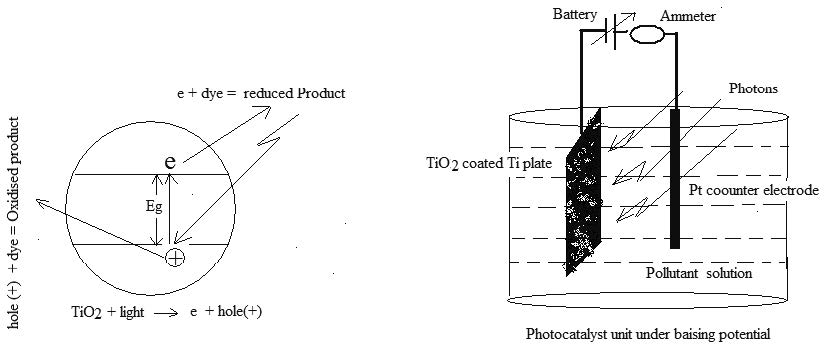
 DownLoad:
DownLoad: 